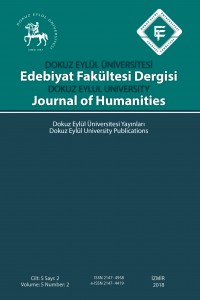Abstract
Bu makale Platon'un formlar
teorisinin bir yorumunu sunmayı amaçlamaktadır.
Bu yorumla hem formların doğası açıklanacak hem de bu teorinin sınırları
gösterilecektir. Platon'un fikirlerine etki eden felsefi düşüncelerin ışığında,
Platon'un formlar teorisinin, diyaloglarını yazdığı zamanın hakim felsefi
görüşleri olan sofizm ve şüpheciliğe karşı bir tepki olarak ortaya çıktığını
savunuyorum. Daha spesifik olarak, Platon'un, formlar öğretisini, ahlaki
şüpheciliğe ve sofistlerin rölativist eğilimlerine karşı geliştirdiğini ve bu
alternatif teoriyi evrensel olarak geçerli ahlaki değerlerin varlığını
gerekçelendirmek için tasarladığını ileri sürüyorum. Platon’un ilk motivasyonu
evrensel etik hakikatlerin varlığını haklı çıkarmak olsa da, sofistlerin
rölativist argümanlarını çürütme isteği, genel olarak ebedi hakikatlere dair
bilgi edinme olasılığını gösterebileceği daha iddialı bir projeyi üstlenmesini
sağlamıştır. Platon’un formlar teorisinin başlıca motivasyonunu ve kapsamını
belirledikten sonra, bu çalışmada ayrıca formların doğası aydınlatılacak ve de
formlar ile tikel nesneler arasındaki ilişkinin geçişsizliği gösterilecektir.
Keywords
References
- Annas, J. (1958). Introduction to Plato’s Republic, New York, Oxford University Press.
- Grube, G. M. A. (1958). Plato’s Thought, Boston, Beacon Press.
- Penner, T., (1992). The Cambridge Companion to Plato, ed. by, Richard Kraut, New York, Cambridge University Press.
- Plato, (1997). ‘Meno’ in Plato Completed Works, Ed. J. M. Cooper, Indianapolis, Hackett Publishing Company.
- Plato, (1997). ‘Parmenides’ in Plato Completed Works, Ed. by J. M. Cooper, Indianapolis, Hackett Publishing Company.
- Plato, (1997). ‘Pheado’ in Plato Completed Works, Ed. J. M. Cooper, Hackett Indianapolis, Hackett Publishing Company.
- ‘Plato, (1997). Republic’ in Plato Completed Works, Ed. J. M. Cooper, Hackett Indianapolis, Hackett Publishing Company.
- Plato, (1997). ‘Sophist’ in Plato Completed Works, Ed. J. M. Cooper, Hackett Indianapolis, Hackett Publishing Company.
- Plato, (1997). ‘Symposium’ in Plato Completed Works, Ed. by J. M. Cooper, Indianapolis, Hackett Publishing Company.
- Plato, (1997). ‘Theaetetus’ in Plato Completed Works, Ed. by J. M. Cooper, Indianapolis, Hackett Publishing Company.
- Plato, (1997). ‘Timaeus’ in Plato Completed Works, Ed. by J. M. Cooper, Indianapolis, Hackett Publishing Company.
Abstract
This essay aims to offer an interpretation of Plato’s theory of forms, which clarifies the nature of the forms and determine the limits of the theory. In light of the philosophical background that influenced Plato’s thinking, I argue that the theory of forms emerges as a reaction to sophism and skepticism, which were the prevailing philosophical positions by the time Plato wrote his dialogues. More specifically, I argue that Plato responds to the moral skeptics and the relativistic tendencies of the sophists by developing an alternative theory, namely the theory of forms, which is designed to justify the existence of universally valid moral values. Although Plato’s initial motivation was to justify the existence of universally valid ethical truths, his ambition to refute sophists’ relativist arguments led him to undertake a more ambitious project through which he could demonstrate the possibility of attaining knowledge of eternal truths in general. Having determined Plato’s main motivation for and the scope of the theory of forms, this paper will also illuminate the nature of the forms and demonstrate the intransitive relationship between the forms and the particular objects.
References
- Annas, J. (1958). Introduction to Plato’s Republic, New York, Oxford University Press.
- Grube, G. M. A. (1958). Plato’s Thought, Boston, Beacon Press.
- Penner, T., (1992). The Cambridge Companion to Plato, ed. by, Richard Kraut, New York, Cambridge University Press.
- Plato, (1997). ‘Meno’ in Plato Completed Works, Ed. J. M. Cooper, Indianapolis, Hackett Publishing Company.
- Plato, (1997). ‘Parmenides’ in Plato Completed Works, Ed. by J. M. Cooper, Indianapolis, Hackett Publishing Company.
- Plato, (1997). ‘Pheado’ in Plato Completed Works, Ed. J. M. Cooper, Hackett Indianapolis, Hackett Publishing Company.
- ‘Plato, (1997). Republic’ in Plato Completed Works, Ed. J. M. Cooper, Hackett Indianapolis, Hackett Publishing Company.
- Plato, (1997). ‘Sophist’ in Plato Completed Works, Ed. J. M. Cooper, Hackett Indianapolis, Hackett Publishing Company.
- Plato, (1997). ‘Symposium’ in Plato Completed Works, Ed. by J. M. Cooper, Indianapolis, Hackett Publishing Company.
- Plato, (1997). ‘Theaetetus’ in Plato Completed Works, Ed. by J. M. Cooper, Indianapolis, Hackett Publishing Company.
- Plato, (1997). ‘Timaeus’ in Plato Completed Works, Ed. by J. M. Cooper, Indianapolis, Hackett Publishing Company.
Details
| Primary Language | English |
|---|---|
| Journal Section | Articles |
| Authors | |
| Publication Date | October 24, 2018 |
| Submission Date | August 19, 2018 |
| Published in Issue | Year 2018 Volume: 5 Issue: 2 |

